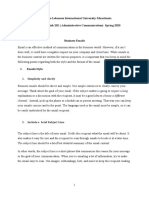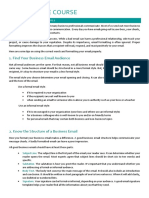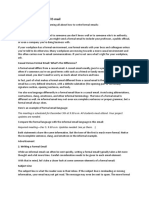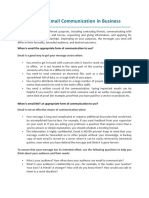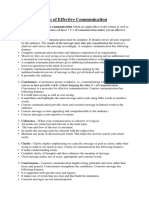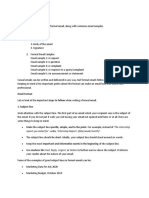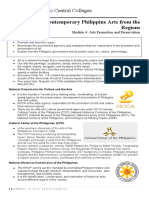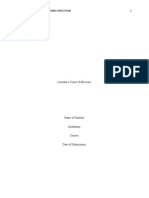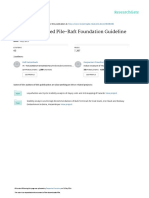0 ratings0% found this document useful (0 votes)
22 viewsSchiess Email Like A Lawyer
Schiess Email Like A Lawyer
Uploaded by
Devender SinghCopyright:
© All Rights Reserved
Available Formats
Download as PDF, TXT or read online from Scribd
Schiess Email Like A Lawyer
Schiess Email Like A Lawyer
Uploaded by
Devender Singh0 ratings0% found this document useful (0 votes)
22 views5 pagesOriginal Title
Schiess Email Like a Lawyer
Copyright
© © All Rights Reserved
Available Formats
PDF, TXT or read online from Scribd
Share this document
Did you find this document useful?
Is this content inappropriate?
Copyright:
© All Rights Reserved
Available Formats
Download as PDF, TXT or read online from Scribd
Download as pdf or txt
0 ratings0% found this document useful (0 votes)
22 views5 pagesSchiess Email Like A Lawyer
Schiess Email Like A Lawyer
Uploaded by
Devender SinghCopyright:
© All Rights Reserved
Available Formats
Download as PDF, TXT or read online from Scribd
Download as pdf or txt
You are on page 1of 5
5 '!l J E[ T: ~1 E ET I'~ t!
2:Z I STUDENT LAWYER I May 2007
Electronic copy available at: http://ssrn.com/abstract=1341270
E-Mail Like a Lawyer
As one of the most common-and commonly
misused-forms of business communication,
e-mail can enhance or hinder your professional
success. That's why it pays to evaluate your e-mail
habits and make appropriate improvement~
BY WAYNE SCHIESS
ost professionals know from experience the
truth about what Lynne Agress writes in
Working With Words in Business and Legal
Writing: "[E-Jmail ... has encouraged just
about everyone to try his or her hand at
writing off-the-cuff, with little or no prepa-
ration or forethought. As a result, lawyers,
architects, accountants-all business people, in fact-have been given
an equal opportunity to embarrass themselves."
Embarrassing yourself is obviously something you don't want to do
when you work in a law office. Stated more positively, when you enter
the practice of law, you enter a professional environment. Your e-mail
messages are professional communications, and they reflect your pro-
fessional demeanor.
Never take for granted the sensible use of e-mail by lawyers. As recent-
ly as the fall of 2006, the Maine Bar Journal included an article titled "E-
mail for Lawyers: Cause for Celebration and Concern." It was only the lat-
est in a series of published advice for lawyers in recent years about the
potential pitfalls and abuses of communicating bye-mail.
As you embark on your legal career, remember this: Every e-mail mes-
sage you send on the job says something about you and your professi~n
alism. In fact, e-mail keeps on saying something about you long after
you've sent the message. Whether by intentional forwarding or by an
accidental "reply to all," your messages live on and can come back to you
in unexpected ways.
Whether you're a novice or seasoned business pro, it's a good idea to
review your e-mail practices regularly and make necessary improve-
ments. Use this article to get you started.
JIM STARR May 2007 I STUDENT LAWYER I :zJ
Electronic copy available at: http://ssrn.com/abstract=1341270
First, a few threshold matters: Think about whether you should send subject line-a subject line that now has
• Don't use smileys, other emoticons, an e-mail message at all. Often, a real let- nothing to do with the current message.
and abbreviations like LOL that are ap- ter is better than an e-mail message. No The same is true of multiple replies to
propriate for personal text messages but matter how formally worded an e-mail replies. The subject line, which busy
not in the office. message is, it's still less formal than a readers use to sort and prioritize their
• Use standard capitalization, punctu- hard-copy letter. If the formality and se- messages, loses its value when senders
ation, and spelling. riousness of a real letter are called for, don't bother to update it. Using a clear
• Edit and proofread your messages write one. Sometimes a phone call is a and accurate subject line allows readers
as carefully as you would a letter. better option. Use the phone when you to easily skim their inbox and read mes-
• Above all, assume that the recipient need an immediate response, when you sages by priority of importance.
will judge you by your e-mail messages. need to ask questions and negotiate, or The general counsel of a nonprofit or-
Think about how you sound and what a when you have concerns about privacy. ganization told me that he once got an im-
reader might think. "Beware the Ease of E-mail" is the title portant e-mail message requiring his ur-
__With these points in mind, here are of a 2003 New York Law Journal article gent attention. The subject line was
more to consider for sending the right by Jeffrey Fuisz and Alison King, lawyers "Rosie's birthday party." This resulted
(e-mail) message. at Kaye Scholer in New York. The authors from the sender's use of an earlier, unre-
advise asking the following questions be- lated message as the vehicle to forward a
Think. Pause. Think again. fore sending an e-mail message: new message. But because the general
Send • Would you be comfortable if every- counsel received a large volume of e-mail,
E-mail's speed often causes senders to one on your team saw the e-mail you are he put the "Rosie's birthday" message at
write, reply, or forward too quickly. And sending? the bottom of his list and didn't get to it
its ease often causes e-mailers to neglect • How would your clients react if they for days.
thoughtful scrutiny. Hence the advice to saw the message? That's why effective e-mailers change
"think, pause, think again, then send." • Are you accomplishing anything and update the subject line-even if only
In my legal writing classes, students constructive with your response? a word or two: so the recipient gets a bet-
often report bad e-mail experiences, most Unless you are comfortable with the ter sense of the current subject. For ex-
caused by haste. Some arise when a sum- answers to all three questions, Fuisz and ample, suppose you received an original
mer clerk hits "reply to all" instead of King write, don't send the message. message that has this subject line:
"reply" and sends a personal, often nega- Why so many cautions about e-mail?
tive, message to everyone at the office. One word: easy. E-mail messages are Reminder: Rutherford deposition
Others get burned trying to be funny or easy to forward, easy to include in a tomorrow
cute in ways their classmates would un- reply, and easy to include in the most
derstand but lawyers at the office do not. treacherous of e-mail actions: reply to all. You might reply with a subject line
Mistakes from haste happen to When you send an e-mail message to a like this:
lawyers, too. In an incident reported in client, Fuisz and King warn, assume the
The New York Times in April 2002, a client will forward it to others. Your client Confirming Rutherford deposition
lawyer at a major New York firm inad- might even send the message to the op- tomorrow
vertently destroyed the confidentiality of posing side, writes lawyer Frederick Hertz
the bidding process for a bankrupt client. in an August 2002 Texas Lawyer article By replacing just one word, you have
The lawyer was sending a routine e-mail titled "Safe E-mail Practices for Solos." made your e-mail message more helpful
message to all the potential bidders for a As Hertz recalls, "I have had the plea- and more quickly informative to the
bankrupt client. The identities of the sure of reading the complete confidential recipient.
suitors were to be kept secret, but the advice of my opposing counsel when her Besides updating subject lines on
sender inadvertently included the e-mail client forwarded it on to my client as part replies, you can do much to improve sub-
addresses of all the potential bidders. of a back-channel negotiation ploy." ject lines in original messages. Three
Of course, clients can repeat what you tips:
say, and they can photocopy and give • Be specific. Think of the subject line
away your written advice. But these as summarizing the message instead of
Wayne Schiess (wschiess@/aw.utexas.edu), methods of passing along information re- merely defining the topic.
director of legal writing at the University of quire more effort than forwarding e-mail. • Use "FYI" to introduce your mes-
Texas School of Law, practiced law for three sage, or include your recipients in the
years at the Texas firm of Baker Botts. He is Use the subject line "Ce" line, to signal that the message is not
author of Writing for the Legal Audience To be a considerate and clear e-mailer, directed primarily at them.
and Better Legal Writing, and he is an asso- use subject lines effectively. You have cer- • State or hint at requested action in
ciate editor of the Scribes Journal of Legal tainly received a forward of a forwarded the subject line.
Writing. e-mail message that contains the original Here are some examples:
24 I STUDENT LAWYER I May 2007
Instead of: Legal memo text in forwards and replies. If you are re- Ms. Mandel:
plying to someone as part of a continuing
Write: First draft of Coastal Bank thread, you may want to include the text 1. Do you have a suggestion for resolv-
memo attached of previous messages so the reader can ing the price-term impasse? I have a
follow or recall the context. But if you are suggestion below.
Instead of: Impact statement forwarding or replying on an unrelated
topic, you may decide to delete the content 2. Can you meet me Thursday (5/24)
Write: Need Delta site impact state- of previous messages to reduce clutter. for lunch to firm up a closing date?
ment by Friday, 6/1/07 Check your e-mail program's default set-
tings to see if the text of previous mes- Suggestion on price term:
By using the subject line to summa- sages is automatically included or not,
rize the message and to give the reader a and adjust them to meet your needs. Since we both agree that the exact
clue about the content and the purpose of sales price will depend on the then-
the message, you set yourself apart from Use short paragraphs current market price, I suggest that we
run-of-the-mill e-mailers. in block style incorporate a market-price provision
A short message with short paragraphs into the contract rather than waiting
Use a salutation is more likely to be read and understood. for the closing date to get closer so
When you work in a law office and send After all, that's what e-mail is really for: that we can get the exact price into
e-mail messages to colleagues, profes- short, quick messages. Long paragraphs, the contract.
sional etiquette requires that you begin like long messages, deter readers even
with a salutation- a sign or expression more in e-mail than in other media. So I have drafted market-price terms in
of greeting. Perhaps you think of the write in short chunks. other contracts, and I know that it can
"To" line as all the "greeting" you need. And present those chunks in readable work. I have the language ready to go
But most e-mail recipients don't consider format. Don't bother indenting the first and would be happy to send it along
the "To" line to even be part of the mes- line of each paragraph in an e-mail mes- for your review. I'm also open to con-
sage. So use a salutation, and adjust it to sage. Block style-with an extra hard re- sidering your suggestions ....
the level of appropriate formality: turn between each paragraph- is the
right style for e-mail. This revision will be easier to read
Formal: Dear Ms. Anderson: So instead of looking like this: and respond to.
(with colon)
Moderate: Dear Denise, (with Ms. Mandel: Put the question or
comma or colon) point up front
Informal: Denise, (vyith comma or Since we both agree that the exact The example above did more than break
colon) sales price will depend on the then- up the paragraphs. It also moved the im-
current market price, I suggest that we portant questions from their originallo-
Write short messages incorporate a market-price provision cation-buried in a long paragraph- to
Readers are probably more likely to give into the contract rather than waiting a prominent position up front. If you are
up on reading a long e-mail message than for the closing date to get closer so asking a question in the message, ask it
on any other type of writing. As one that we can get the exact price into first. If the reader needs background to
lawyer told me: "Seven pages of single- the contract. I have drafted market- understand the question, then ask the
spaced text becomes even more oppres- price terms in other contracts, and I question and say that the background
sive when cut-and-pasted into an e-mail." know that it can work well. I have the follows, like this:
So keep it short. language ready to go and would be
As for what is "short," some recom- happy to send it along for your review. Don,
mend the "one screen" rule: Don't send a That's my suggestion to resolve this
message that requires the recipient to small impasse. Do you have any sug- Can you prepare a reply brief in
scroll beyond the first screen. If you do, gestions? I'd be open to considering Henderson v. American Technologies?
you're all but asking the reader to ignore them. The other issue, of course, is You may need some background to be
the later parts of the message. Of coUrse, that the tentative closing date keeps able to answer that, so here it is . ...
you can't know the recipient's screen size getting pushed farther into the year.
or type settings, and you might occasion- We probably need to get together to If you ask the question up front, you're
ally need to write a long message. But err discuss the situation and agree on a more likely to get an answer. If the mes-
on the side of brevity. The longer the firm closing date .... sage had started with the background
message, the more likely that you should about the Henderson case, the reader
be writing a letter or making a phone call. Your e-mail message should look like may have quit reading before getting to
Think about your use of extraneous this: your question.
May 2007 I STUDENT LAWYER I 25
Another helpful technique, recom- the e-mail message to summarize your He granted me an exception to the
mended by Steven Stark, author of Writ- point. Many lawyers resist this idea, say- law-school curve based on three reasons:
ing to Win, is to summarize the question ing to themselves, "I need to give the the small class size (24 students), the
you were asked when you reply. When background first" or "I need to support self-selecting nature ofthe course (i.e.,
you answer a question in a reply, write this idea before I introduce it." Maybe so. students who signed up for this course
something like this: But you'll usually get better results if you probably take legal drafting seriously),
summarize the point first and give the and the fact that I had already graded
Becca, background or support later. and returned two earlier assignments
For example, here are two versions of that were not based on the curve.
You asked if I would be able to work an e-mail message I sent to my students.
on the Henderson reply brief. I do The "before" text is a draft that does not
have the time, but will need to start put the point of the message first. The Explain attachments
tomorrow. I have a 5:00 p.m. deadline "after" text is the final version that Make it a practice to always explain-
fOUlnother brief today.... moved the point of the message up front. early in the message-what you have
attached, in what form, and why. Many
Though the recipient can scroll down Before: e-mail users are rightly concerned about
and reread what she asked you, you opening attachments. So even if it's a
make things clearer and easier by restat- Dear students, harmless document, explain it.
ing the question up front. And give the file you're attaching a
If you're not asking a question but I spoke to the Dean of Academic helpful name. Attaching <memo> or
making a point, use the first sentences of Affairs today about getting an excep- <letter> makes the file harder to recog-
tion to the law school's curve for the IP nize, especially if the recipient doesn't
Drafting course. As you know, I believe open it directly from the message screen.
that I should be allowed to give grades A better name might include the creator's
that are higher than they would be if I name and a date:
conformed to the curve.
• schiess_memo_6-21-03
He granted me an exception to the • martin_demandlettecdraft
law-school curve based on three reasons:
the small class size (24 students), the Finally, don't attach a file to a message
self-selecting nature of the course (i.e., unless your recipient asked for it or
students who signed up for this course might reasonably expect it.
probably take legal drafting seriously),
and the fact that I had already graded
and returned two earlier assignments Use a sign-off
that were not based on the curve. In a letter, you'd always sign off with
something, whether "Sincerely," "Yours
So, as I hoped, the grades for IP Draft- very truly," or "Best regards." You can be
ing do not have to conform to the law less formal in e-mail messages, of course,
school's curve. but in a professional setting, you ought to
sign off. It can be as simple as "Thank you
After: for your help," followed by your name.
Set your e-mail preferences to always
Dear students, include a signature line, but don't get car-
ried away. Keep your signature to a few
As I hoped, the grades for IP Drafting straightforward lines, consisting of your
do not have to conform to the law full name, mailing address, e-mail ad-
school's curve. dress, and perhaps your firm's web site
address. (Your firm may set this up,
I spoke to the Dean of Academic along with any legal disclaimers, as a
Affairs today about getting an excep- standard feature of all staff outgoing e-
tion to the law school's curve for the mails.) And remember that professional
course. As you know, I believe that I e-mail messages never include extrane-
should be allowed to give grades that ous information like "quotes of the
are higher than they would be if I week" or artwork created with punctua-
conformed to the curve. tion marks. ~1.
26 I STUDENT LAWVER I May 2007
You might also like
- Advertisement in The Philippines: History, Evolution, and The Filipino ConsumerDocument12 pagesAdvertisement in The Philippines: History, Evolution, and The Filipino ConsumerZeus LegaspiNo ratings yet
- Violet: Vocal Selections PDFDocument73 pagesViolet: Vocal Selections PDFBrittany Lotshaw4% (25)
- The Question of G. de Purucker: A ReplyDocument46 pagesThe Question of G. de Purucker: A ReplyJon Fergus100% (1)
- Principles of Information Security 4th Edition Whitman Test BankDocument5 pagesPrinciples of Information Security 4th Edition Whitman Test Bankxasuhymu100% (3)
- A Plain English Handbook - SEC - Securities and Exchange CommissionDocument4 pagesA Plain English Handbook - SEC - Securities and Exchange CommissionGiuliana CompagnoNo ratings yet
- E.mail WritingDocument24 pagesE.mail WritingaishuanjaliNo ratings yet
- Lesson 2.2 Email Etiquette PDFDocument2 pagesLesson 2.2 Email Etiquette PDFRonnalyn PereroNo ratings yet
- Business Emails - Style and StructureDocument4 pagesBusiness Emails - Style and StructureFall Eljed100% (1)
- EmailDocument10 pagesEmailKartikey SharmaNo ratings yet
- Tool Kit E-MailsDocument14 pagesTool Kit E-MailsKanchana RandallNo ratings yet
- It Skills ProjectDocument8 pagesIt Skills Projectshubham singhNo ratings yet
- How To Write Professional Emails 12 Etiquette GuidelinesDocument2 pagesHow To Write Professional Emails 12 Etiquette Guidelinessabrine.silvaNo ratings yet
- Tailor-Made Course: 1. Find Your Business Email AudienceDocument4 pagesTailor-Made Course: 1. Find Your Business Email AudienceJuliana XavierNo ratings yet
- Null 2Document51 pagesNull 2Aidrouz LipanNo ratings yet
- Decision Making & Negotiation Assignment No. 1 Submitted ByDocument5 pagesDecision Making & Negotiation Assignment No. 1 Submitted ByMaham WasimNo ratings yet
- Ch.3 - Electronic Messages and Digital MediaDocument22 pagesCh.3 - Electronic Messages and Digital MediasitizulaikahjamilNo ratings yet
- Email Etiquettes - Basics: Insights, Ideas & SuggestionsDocument23 pagesEmail Etiquettes - Basics: Insights, Ideas & SuggestionsAli QaziNo ratings yet
- Email EtiquetteDocument19 pagesEmail Etiquettegrovermehak116No ratings yet
- Email WorkshopDocument29 pagesEmail WorkshopkabirimNo ratings yet
- Week 3Document24 pagesWeek 3Jirah Joy PeañarNo ratings yet
- Writing A Formal EmailDocument7 pagesWriting A Formal EmailMilette CaliwanNo ratings yet
- Business Email WritingDocument5 pagesBusiness Email Writingchaimae bejjaNo ratings yet
- Professional E-Mail WritingDocument12 pagesProfessional E-Mail WritingzoukitonygsNo ratings yet
- PROFFESIONAL EMAIL LESSONDocument5 pagesPROFFESIONAL EMAIL LESSONyangaristia07No ratings yet
- Business Com MidtermDocument6 pagesBusiness Com MidtermChrista Felicia AldayNo ratings yet
- Modul 4-EfBDocument30 pagesModul 4-EfBArdika Rizky AbdillahNo ratings yet
- How To Write A Formal E-MailDocument10 pagesHow To Write A Formal E-MailIqbaal FariziNo ratings yet
- Using E-Mail More EffectivelyDocument6 pagesUsing E-Mail More EffectivelyAna-Maria PopaNo ratings yet
- Technical Writing AssignmentDocument3 pagesTechnical Writing AssignmentSana MazharNo ratings yet
- Email Writing ProcedureDocument7 pagesEmail Writing ProcedureInamul TahsinNo ratings yet
- AssignmentDocument6 pagesAssignmentMuhammad raufNo ratings yet
- emails@work: How to write effective business emailsFrom Everandemails@work: How to write effective business emailsRating: 1 out of 5 stars1/5 (1)
- 2009 - 05 - Is Your Email Businesslike orDocument5 pages2009 - 05 - Is Your Email Businesslike orApril Irish ReyNo ratings yet
- Email Etiquette Workshop: Brought To You by The Purdue University Writing LabDocument28 pagesEmail Etiquette Workshop: Brought To You by The Purdue University Writing Labapi-3720469No ratings yet
- The Structure of Businesses Emails: Prepared By: Kattouche Racha Hanine Group 12Document10 pagesThe Structure of Businesses Emails: Prepared By: Kattouche Racha Hanine Group 12Safaa KattoucheNo ratings yet
- Email EtiquetteDocument27 pagesEmail EtiquetteSangesh NattamaiNo ratings yet
- Business Communication TEM GROUP 4Document5 pagesBusiness Communication TEM GROUP 4aalsmeersenas12No ratings yet
- Email Etiquette PDFDocument10 pagesEmail Etiquette PDFAnand AanuNo ratings yet
- BUSINESS COMMUNICATION FinalDocument13 pagesBUSINESS COMMUNICATION FinalMałgorzata JurczokNo ratings yet
- Email EtiquetteDocument27 pagesEmail Etiquetteapi-3703967No ratings yet
- purpcom reviewerrDocument4 pagespurpcom reviewerrmaineyyyricoNo ratings yet
- Email Writing Course Presentation (Autumn Dream) Lecture 1Document11 pagesEmail Writing Course Presentation (Autumn Dream) Lecture 1Sammy Soe Aung MyintNo ratings yet
- Email Etiquette HandoutDocument5 pagesEmail Etiquette HandoutmohsanmajeedNo ratings yet
- How To Write a Professional EmailDocument7 pagesHow To Write a Professional EmailSalman ShafqatNo ratings yet
- Why Have Email RulesDocument7 pagesWhy Have Email RulesChiranjivi NainiNo ratings yet
- Letters, E-Mails, and MemosDocument19 pagesLetters, E-Mails, and MemosRoyce IbuanNo ratings yet
- Email EtiquetteDocument27 pagesEmail EtiquetteVeeraNo ratings yet
- Email Etiquettes FGDocument41 pagesEmail Etiquettes FGAhmedNo ratings yet
- 22 Critical Skills To Write An Effective EmailDocument10 pages22 Critical Skills To Write An Effective Emailabdelhak.adnane.projectmanagerNo ratings yet
- Chapter Two E-Mail Writing: Spring 2023Document43 pagesChapter Two E-Mail Writing: Spring 2023Ahmad zarahNo ratings yet
- Emails: Employment-Related Email MessagingDocument18 pagesEmails: Employment-Related Email MessagingGabs SolivenNo ratings yet
- 05 CC Professional Email Writing SEM 3Document6 pages05 CC Professional Email Writing SEM 3Vamshi ValasaNo ratings yet
- How To Write An Effective Email With Examples (+tips) - Zoho MailDocument1 pageHow To Write An Effective Email With Examples (+tips) - Zoho MailShahira IssufoNo ratings yet
- Email Etiquette - What Is Email Etiquette?: How Should I Format My Email?Document4 pagesEmail Etiquette - What Is Email Etiquette?: How Should I Format My Email?Alex AlexandruNo ratings yet
- 25 Tips For Perfecting Your EmailDocument6 pages25 Tips For Perfecting Your EmailMichael VillaNo ratings yet
- Computer 10 Quarter 1 Lesson 2Document17 pagesComputer 10 Quarter 1 Lesson 2Ella MendozaNo ratings yet
- Email Writen ReportDocument18 pagesEmail Writen ReportMelinda SilorioNo ratings yet
- Eml EtiDocument33 pagesEml EtiThahir MohamedNo ratings yet
- PresentationDocument20 pagesPresentationRainaNo ratings yet
- ÍndiceDocument19 pagesÍndiceMiguel Antonio Miguel G-TOYNo ratings yet
- Writing Emails That People Want To ReadDocument23 pagesWriting Emails That People Want To ReadRuslan AgayevNo ratings yet
- Handout - Email EtiquetteDocument4 pagesHandout - Email Etiquettesaurabhandhale14No ratings yet
- How To Write EmailsDocument8 pagesHow To Write Emailsthugnature100% (1)
- Anche Company Has Organized Its Accounts Receivable by Customer andDocument1 pageAnche Company Has Organized Its Accounts Receivable by Customer andLet's Talk With HassanNo ratings yet
- A.112 B.118 C.121 D.124: Airtel Placement Paper QuestionsDocument8 pagesA.112 B.118 C.121 D.124: Airtel Placement Paper QuestionsAvdhut Gopewad100% (1)
- 18) Complications of General Anaesthesia - Neurological ComplicationsDocument2 pages18) Complications of General Anaesthesia - Neurological Complicationskarim hassanNo ratings yet
- Factors_related_to_exercise_over_the_cou (4)Document9 pagesFactors_related_to_exercise_over_the_cou (4)Conny SalasNo ratings yet
- PDF Broken Glass Caleb Cushing the Shattering of the Union First Edition John M. Belohlavek downloadDocument85 pagesPDF Broken Glass Caleb Cushing the Shattering of the Union First Edition John M. Belohlavek downloadryukabraar100% (5)
- Week7 Equity MKT 1: You Have CompletedDocument5 pagesWeek7 Equity MKT 1: You Have CompletedDerek LowNo ratings yet
- School of Thoughts in PsychologyDocument10 pagesSchool of Thoughts in PsychologyZulaikha NasrullahNo ratings yet
- Vibhuti PadaDocument50 pagesVibhuti PadaAnkit LatiyanNo ratings yet
- ABAP 7.4 SyntaxDocument18 pagesABAP 7.4 SyntaxJaya SankarNo ratings yet
- Cross Walk Sec-93Document12 pagesCross Walk Sec-93a.dea.a.day3No ratings yet
- MG4C2 (2023-24) Lecture 11 Handout - SLIDES (Org Culture)Document30 pagesMG4C2 (2023-24) Lecture 11 Handout - SLIDES (Org Culture)Rashmi SinghNo ratings yet
- Soal UT MKDU4107 Bahasa Inggris IDocument7 pagesSoal UT MKDU4107 Bahasa Inggris Ixcn VanilaNo ratings yet
- Contemporary Philippine Arts From The Regions: Republic Central CollegesDocument2 pagesContemporary Philippine Arts From The Regions: Republic Central CollegesJoshua BarteNo ratings yet
- Seasons and Celebrations Sample ChaptersDocument15 pagesSeasons and Celebrations Sample ChaptersMD NAZEERNo ratings yet
- SEC08-20 Rehabilitation TechnologyDocument2 pagesSEC08-20 Rehabilitation TechnologyJuliana Orjuela Garcia100% (1)
- Beef Served To Animals of DR. Shyamaprasad Mukerjee Zoological Garden, Municipal Corporation, Surat, GujaratDocument31 pagesBeef Served To Animals of DR. Shyamaprasad Mukerjee Zoological Garden, Municipal Corporation, Surat, GujaratNaresh KadyanNo ratings yet
- Corporate Responsibility & Sustainability: Policy 2020 - IndiaDocument14 pagesCorporate Responsibility & Sustainability: Policy 2020 - Indiarajiv luwangNo ratings yet
- Running Head: Literature Course Reflection 1Document4 pagesRunning Head: Literature Course Reflection 1Paul WahomeNo ratings yet
- What, Approximately, Is The Average Height of The Tropopause Over The Equator ?Document40 pagesWhat, Approximately, Is The Average Height of The Tropopause Over The Equator ?Daniel MkenyaNo ratings yet
- Towards A General Theory of Translation Action. Skopos Theory Explained. Katharina Reiss and Hans J. Vermeer. Translated by Christiane NordDocument240 pagesTowards A General Theory of Translation Action. Skopos Theory Explained. Katharina Reiss and Hans J. Vermeer. Translated by Christiane NordHadjer100% (2)
- Annas Virtue Ethics and Social PsychologyDocument40 pagesAnnas Virtue Ethics and Social PsychologybrainbucketNo ratings yet
- Volatile Matter in The Analysis Sample of Coal and Coke: Standard Test Method ForDocument7 pagesVolatile Matter in The Analysis Sample of Coal and Coke: Standard Test Method ForPOSSDNo ratings yet
- Pages From RFP - DPR - Resort in Sohra - MeghalayaDocument2 pagesPages From RFP - DPR - Resort in Sohra - MeghalayaAnkit kumarNo ratings yet
- Importance of Technology in NursingDocument6 pagesImportance of Technology in NursingTenIs ForMeNo ratings yet
- ISSMGE Combined Pile-Raft Foundation Guideline: July 2013Document29 pagesISSMGE Combined Pile-Raft Foundation Guideline: July 2013Chandu ManneNo ratings yet
- Presence of Mind and Communication Skills of Dr. C. N. AnnaduraiDocument10 pagesPresence of Mind and Communication Skills of Dr. C. N. AnnaduraiNihal AshikNo ratings yet








